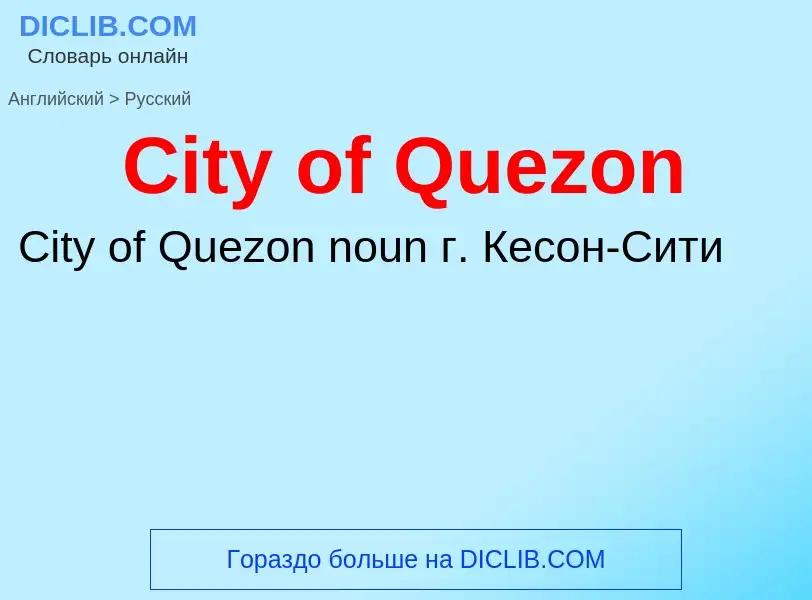Traduzione e analisi delle parole tramite l'intelligenza artificiale ChatGPT
In questa pagina puoi ottenere un'analisi dettagliata di una parola o frase, prodotta utilizzando la migliore tecnologia di intelligenza artificiale fino ad oggi:
- come viene usata la parola
- frequenza di utilizzo
- è usato più spesso nel discorso orale o scritto
- opzioni di traduzione delle parole
- esempi di utilizzo (varie frasi con traduzione)
- etimologia
Quezon City - traduzione in Inglese
['keisɔn'siti]
география
г. Кесон-Сити
существительное
общая лексика
г. Кесон-Сити
Definizione
Wikipedia

Quezon City (UK: , US: ; Filipino: Lungsod Quezon [luŋˈsod ˈkɛson]), also known as the City of Quezon and Q.C. (read and pronounced in Filipino as Kyusi), is the most populous city in the Philippines. According to the 2020 census, it has a population of 2,960,048 people. It was founded on October 12, 1939, and was named after Manuel L. Quezon, the second president of the Philippines.
The city was intended to be the national capital of the Philippines that would replace Manila, as the latter was suffering from overcrowding, lack of housing, poor sanitation, and traffic congestion. To create Quezon City, several barrios were carved out from the towns of Caloocan, Marikina, San Juan and Pasig, in addition to the eight vast estates the Philippine government purchased for this purpose. It was officially proclaimed as the national capital on October 12, 1949, and several government departments and institutions moved out of Manila and settled into the new capital city. This necessitated the expansion of the city northwards, carving out Novaliches from Caloocan which divided it into two non-contiguous parts. Several barrios were also taken from San Mateo and parts of Montalban. However, on June 24, 1976, Presidential Decree 940 was enacted, which reverted national capital status to Manila while the whole of Metro Manila was designated as the seat of government. The city was also chosen as the regional center of Southern Tagalog, which was created in 1965, along with province named after Manuel Quezon and Aurora, the latter is his birthplace; however, its status of regional center became ineffective when the region was divided into Calabarzon and Mimaropa, through the effect of Executive Order No. 103 in May 2002 under the administration of Gloria Macapagal-Arroyo, and Aurora was transferred to the authority of Central Luzon, with Southern Tagalog limited to being a cultural-geographic region.
Quezon City is known for its culture, entertainment industry and media, and is aptly called the "City of Stars". Major broadcasting networks have their headquarters and studios in the city. It is also known for its commerce, education, research, technology, politics, tourism, art and sports. Several national government branches including the Batasang Pambansa Complex, the seat of House of Representatives of the Philippines, calls the city home.
Quezon City is a planned city. It covers a total area of 161.11 square kilometers (62.20 sq mi), making it the largest city in Metro Manila in terms of land area. It is politically subdivided into Six Congressional Districts, which represents the city in the Lower House of the Congress of the Philippines. The city has 142 barangays under the City Government. National government departments and agencies are mostly situated at the National Government Center I (NGC I) in Diliman, and the National Government Center II (NGC II) in Batasan Hills, where the Lower House of the Philippine Congress is located. Most of the city's northern part lies at the foothills of the Sierra Madre mountain range, including the La Mesa Watershed Reservation, the largest watershed in Metro Manila and a designated protected area.


![[[Balete Drive]] in New Manila is known in Filipino folklore as a haunted place, where a [[white lady]] purportedly appears. [[Balete Drive]] in New Manila is known in Filipino folklore as a haunted place, where a [[white lady]] purportedly appears.](https://commons.wikimedia.org/wiki/Special:FilePath/7975Balete Drive Quezon City Landmarks 34.jpg?width=200)
![[[ABS-CBN Broadcasting Center]], in Diliman also serving as the headquarters of [[ABS-CBN]]. [[ABS-CBN Broadcasting Center]], in Diliman also serving as the headquarters of [[ABS-CBN]].](https://commons.wikimedia.org/wiki/Special:FilePath/ABS-CBN, side view (Sgt. Esguerra, Quezon City)(2019-05-27).jpg?width=200)
.jpg?width=200)
![Central Temple]] of the [[Iglesia ni Cristo]] Central Temple]] of the [[Iglesia ni Cristo]]](https://commons.wikimedia.org/wiki/Special:FilePath/Iglesia ni Cristo Central Temple (Commonwealth Avenue, Quezon City)(2018-02-07).jpg?width=200)


![[[Manuel L. Quezon]], the second [[president of the Philippines]] and the visionary behind the creation of Quezon City is the namesake of the city. [[Manuel L. Quezon]], the second [[president of the Philippines]] and the visionary behind the creation of Quezon City is the namesake of the city.](https://commons.wikimedia.org/wiki/Special:FilePath/Manuel Quezon LCCN2011647833 (cropped).jpg?width=200)

![[[Tandang Sora National Shrine]] in Balintawak is dedicated to [[Melchora Aquino]], who was a prominent figure in the [[Philippine Revolution]]. [[Tandang Sora National Shrine]] in Balintawak is dedicated to [[Melchora Aquino]], who was a prominent figure in the [[Philippine Revolution]].](https://commons.wikimedia.org/wiki/Special:FilePath/Tandang Sora Shrine 02.jpg?width=200)

